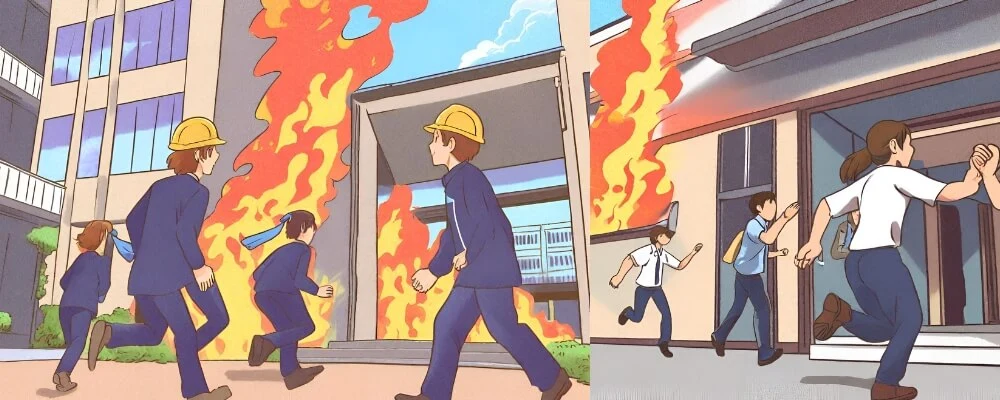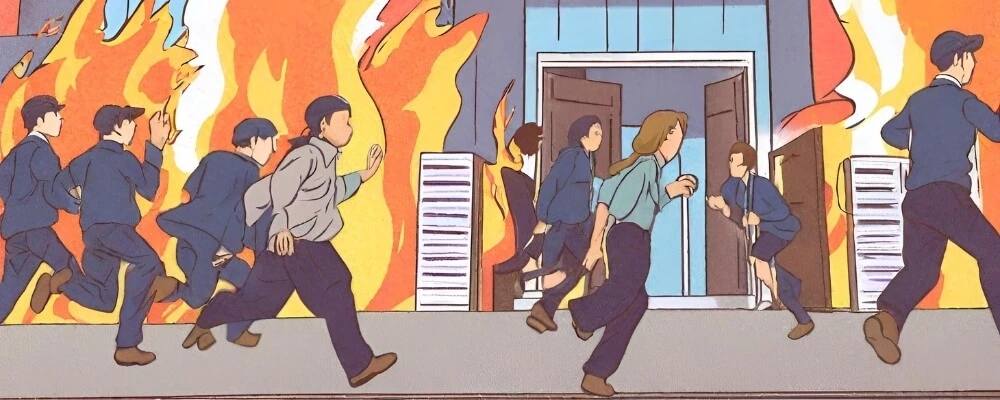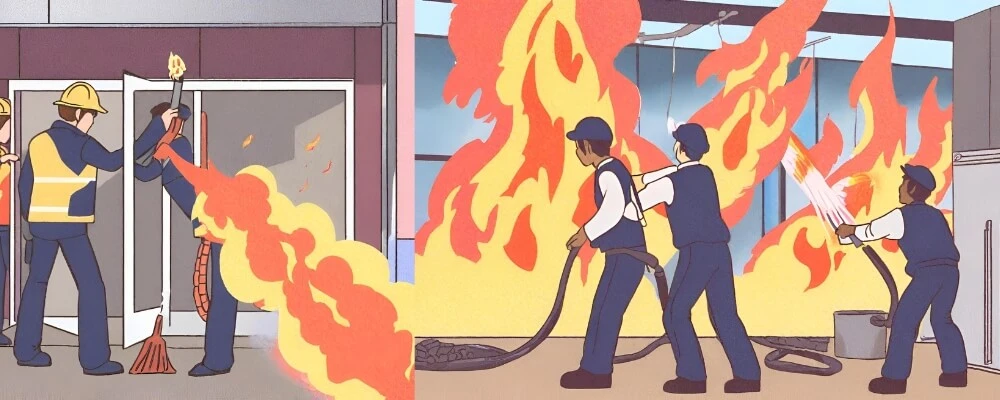In any workplace, safety should always be a top priority. But how often do we consider the importance of being prepared for a fire emergency? This blog delves deep into the significance of fire drills at work and why they are crucial for the protection of everyone on the premises. We’ll walk you through a comprehensive step-by-step guide on the fire drill procedure, emphasizing the importance of regular evaluations and continuous improvements.
Furthermore, we’ll explore effective strategies for conducting these drills and shed light on the critical role of a fire evacuation plan. By the end of this read, you’ll understand not just the ‘how’ but also the ‘why’ behind these life-saving practices. Join us as we navigate the essentials of fire safety preparedness in the workplace.
Why Fire Drills at Work Are Important? How It Helps Protect Everyone
Fire drills at work are far more than a mere regulatory obligation or a tick on the health and safety checklist. They play a pivotal role in safeguarding every employee within the workplace. Here’s a deeper dive into their importance:
- Life-Saving Preparedness: At its core, a fire drill is a life-saving initiative. When a real fire or other emergency, such as a terrorist attack or active shooter event, erupts, the chaos and panic can be overwhelming. Regular fire drills, however, equip every employee with the knowledge and confidence to respond quickly. By practicing fire evacuation procedures, employees are trained to exit the building in an orderly and efficient manner, minimizing the risk of injury or loss of life.
- Familiarity with Evacuation Routes: One of the primary objectives of a fire drill at work is to familiarize employees with the evacuation route. This ensures that in the event of a real fire or emergency, employees won’t waste precious time figuring out their escape path. Instead, they’ll know exactly where the nearest exit and emergency exits are, allowing for a swift and safe evacuation.
- Testing the Alarm System and Fire Procedures: Fire drills provide an opportunity to test the building’s fire alarm system, ensuring it’s loud enough for every employee to hear the alarm and respond. It also allows the safety team to assess the effectiveness of the fire procedures in place and make necessary adjustments.
- Training New Employees: As workplaces evolve and new employees join, it’s crucial that they, too, are well-versed in fire safety. Regular fire drills ensure that new employees, as well as seasoned ones, are consistently updated and trained on the best practices of fire safety and evacuation.
- Protecting Assets and Business Continuity: Beyond the invaluable human life, fire drills also play a role in protecting the tangible and intangible assets of a business. A well-executed evacuation can prevent further damage to assets, and by ensuring employees know how to respond in emergencies, businesses can also reduce downtime and ensure quicker resumption of operations post an incident.
- Building Confidence and Reducing Panic: Knowing what to do in an emergency can significantly reduce panic. When employees participate in regular fire drills, they become more confident in their ability to handle real emergencies. This confidence can be the difference between chaos and an orderly evacuation.
- Collaboration with Local Authorities: Fire drills often involve coordination with the local fire department. This collaboration ensures that in the event of a workplace fire, there’s a seamless integration between the internal safety measures of the business and the external response from fire protection agencies.
In essence, fire drills at work are a proactive approach to a potential emergency. They ensure that businesses are not just reactive when disaster strikes but are well-prepared and equipped to handle it, ultimately aiming to save lives and protect assets.

Fire Drill Procedure At Work: Step By Step Guide
Ensuring the safety of employees in the workplace is of utmost importance, and one of the key components of safety preparedness is conducting regular fire drills. A well-executed fire drill educates employees on the best practices during emergencies, ensuring a swift and orderly response.
Here’s a detailed step-by-step guide to help organizations conduct an effective fire drill:
Step 1: Preparation
The initial phase of any fire drill procedure is the preparation. This stage is foundational and determines the effectiveness of the entire drill. Employees, being the primary participants, need comprehensive training on fire safety measures. This training should encompass understanding the nature of fires, the importance of quick response, and the correct use of fire safety equipment.
Additionally, they should be made familiar with the layout of the workplace, especially pinpointing the emergency exits and identifying the nearest exit from their specific workstations. Beyond training, the safety team has a responsibility to ensure that all safety equipment, particularly smoke detectors and the alarm system, are in optimal working condition. This is vital because, during an emergency, these systems serve as the primary alert mechanism, and any malfunction could lead to catastrophic results.
Step 2: Announcement
The debate between surprise drills and announced drills is ongoing. However, there’s undeniable value in informing employees about an impending drill. While surprise drills mimic the unpredictability of real emergencies, pre-informed drills allow employees, especially those new to the organization, to prepare for the exercise mentally.
This mental preparedness ensures that every employee, regardless of their tenure, actively participates and benefits from the drill.
Step 3: Initiation
The activation of the fire alarm marks the commencement of the drill. This loud, piercing sound is the cue for all employees to begin the evacuation process. The immediate reaction to the alarm is crucial.
Employees should be trained to resist the urge to panic, as panic can lead to confusion, mistakes, and potential injuries. Instead, upon hearing the alarm, they should promptly but calmly leave their workstations, ensuring they don’t trample over others or leave behind any potential fire hazards.
Step 4: Evacuation
The evacuation process is the heart of the fire drill. Employees should have a clear path in mind, following the pre-determined evacuation route. Signages and floor markings can aid in guiding them towards the exits. It’s imperative to note that elevators pose significant risks during fires due to potential electrical malfunctions and should be strictly avoided. Stairwells, being more reliable, should be the primary means of vertical evacuation.
As a best practice, lights should be left on, especially in corridors and stairwells, to ensure visibility and guide employees, particularly if the drill simulates conditions of smoke or power outages.
Step 5: Assembly
Evacuating the building is half the task. Once outside, employees should move to a pre-designated assembly point, ensuring they are at a safe distance from the building. This assembly is not just a gathering; it’s a roll call to account for every individual.
The team leader or an appointed fire warden should methodically take a headcount, ensuring that every employee has safely evacuated. Any discrepancies in this count during a real emergency can provide critical information to first responders.
Step 6: Evaluation
Reflection and assessment are as crucial as the drill itself. Once the drill concludes, the safety committee should gather to evaluate its effectiveness. This isn’t just a cursory overview but a deep dive into every aspect of the drill. Feedback should be actively sought from all participants to understand their experiences, challenges, and suggestions.
Areas of confusion, bottlenecks at exits, or any other hindrances faced during the drill should be meticulously noted. This feedback becomes the foundation for refining future drills, ensuring that with each iteration, the organization becomes better prepared for real emergencies.

Conducting a Successful Fire Drill: Evaluating and Improving Fire Drills
The act of evacuating a building doesn’t solely determine a fire drill’s success. True success lies in the nuances: the speed of evacuation, the safety measures adhered to, and the orderliness of the entire process.
A drill is more than just a practice run; it’s a diagnostic tool to assess an organization’s preparedness and to identify areas for improvement. Here’s a detailed examination of how to evaluate and refine fire drills:
1. Speed of Evacuation
- Time Tracking: From the moment the alarm sounds to the last person reaching the assembly point, every second counts. It’s crucial to measure the time taken for complete evacuation. Comparing this duration against previous drills or industry benchmarks can provide insights into efficiency.
- Quick Response: Monitoring the immediate response of employees once the alarm rings can provide insights into their preparedness. Hesitation or confusion can indicate areas where further training might be required.
2. Safety Adherence
- Equipment Usage: Ensure that employees know how to use safety equipment, such as fire extinguishers, without endangering themselves or others. Observing their interaction with such equipment during drills can highlight knowledge gaps.
- Evacuation Path: Employees should avoid shortcuts and stick to the designated evacuation routes. These routes are designed considering various safety factors. Any deviation might indicate a lack of clarity or the need for better signage.
3. Orderliness
- Calmness Under Pressure: Panic can lead to chaos. Observing how employees maintain composure, avoid shouting, or resist the urge to push and shove can provide a measure of their mental preparedness.
- Role Adherence: Certain employees might have designated roles during emergencies, such as guiding others or ensuring areas are clear. Assessing how well they stick to these roles is crucial.
4. Feedback Collection
- Open Forums: After the drill, hold open forums or debriefing sessions where employees can share their experiences. This firsthand account is invaluable.
- Surveys: Anonymous surveys can encourage more candid feedback, allowing employees to voice concerns or suggestions they might be hesitant to share openly.
5. Actionable Insights
- Identifying Bottlenecks: Feedback might highlight areas where congestion occurs, leading to delays in evacuation. Such bottlenecks might require rerouting or clearer signage.
- Training Gaps: If employees express uncertainty about any aspect of the drill, it indicates a gap in training. For example, if they struggled to find exits, future training sessions might need to emphasize evacuation routes more prominently or even introduce alternative routes.
6. Continuous Improvement
- Iterative Process: One drill is not enough. Regularly scheduled drills, combined with the continuous feedback loop, ensure that the process is always improving.
- External Expertise: Consider bringing in external fire safety experts to observe and evaluate drills. Their fresh perspective and expertise can offer insights that might be overlooked internally.
The real value of a fire drill lies in its aftermath—the evaluation and the actionable steps taken to improve. By meticulously analyzing every aspect of the drill and actively seeking feedback, organizations can ensure that they are always moving closer to the ideal response in the face of an emergency.

Effective Ways On How To Conduct A Fire Drill at Workplace
In the realm of workplace safety, fire drills play a pivotal role. They not only prepare employees for potential fire emergencies but also instill a sense of discipline and orderliness during crises. However, the effectiveness of a fire drill is determined by how it is conducted. Here are some proven strategies to ensure your fire drill is both efficient and impactful:
1. Simulate Real Scenarios
The primary purpose of a fire drill is to prepare employees for potential emergencies. To make this preparation as effective as possible, it’s essential to simulate conditions that closely mirror real-life scenarios. By doing so, employees are not just going through the motions but are genuinely learning how to respond to unexpected challenges. For instance:
2. Blocked Exits
In a real fire, it’s entirely possible for certain exits or pathways to be obstructed, either by fire, debris, or smoke. Simulating such conditions by intentionally blocking one of the fire exits during a drill can test employees’ adaptability. It forces them to think on their feet, find alternative routes, and not rely solely on their routine evacuation path. This exercise enhances their problem-solving skills under pressure and ensures they are familiar with multiple evacuation routes.
3. Regular Intervals
Consistency is key when it comes to preparedness. Fire drills should not be a one-off event but a regular feature of the workplace’s safety protocol.
- Consistent Preparedness: By scheduling fire drills at regular intervals, such as quarterly, employees are kept in a state of readiness. This regularity ensures that the procedures remain fresh in their minds, reducing the likelihood of panic or confusion during a real emergency.
- Inclusion of New Employees: Workplaces often see a turnover of staff. Regular drills ensure that even the newest members of the team are as prepared as those who have been with the company for years. It ensures a uniform level of preparedness across the board.
4. Incorporate Various Emergencies
While fires are a significant concern, they aren’t the only emergency scenario a workplace might face.
- Diverse Training: By incorporating various emergencies into drills, employees are prepared for a broader range of incidents. This could include training for natural disasters, terrorist attacks, active shooter situations, or even medical emergencies. Such diverse training ensures a more comprehensive safety protocol and equips employees with a versatile set of response skills.
- Realistic Expectations: Different emergencies require different responses. For instance, while the primary reaction to a fire might be evacuation, an active shooter situation might require employees to hide or barricade themselves. Training for various emergencies sets clear and realistic expectations for employees, ensuring they know the best course of action for different scenarios.
5. Collaborate with Local Authorities
No organization is an island, especially when it comes to safety. Collaborating with external experts can significantly enhance the effectiveness of fire drills.
- Expert Insights: Local fire departments or national fire protection agencies have a wealth of experience and expertise. By engaging with them, workplaces can gain insights into best practices, common mistakes, and innovative safety measures. These experts can observe drills, provide feedback, and even offer hands-on training sessions.
- Resource Sharing: Collaboration can also lead to resource sharing. This could include educational materials, training tools, or even equipment. Such resources can elevate the quality of the drill and ensure it aligns with the latest safety standards.
In essence, conducting an effective fire drill is a multifaceted endeavor. It requires realism, consistency, versatility, and collaboration. By focusing on these aspects, workplaces can ensure that their fire drills are not just procedural formalities but genuinely impactful training sessions that enhance overall safety.

Why Fire Evacuation Plan Is Important In a Fire Drill?
A fire evacuation plan isn’t merely a document or a set of instructions; it’s the cornerstone of ensuring safety during fire emergencies. Its importance in fire drills and real-life emergencies cannot be overstated. Here’s a detailed exploration of its significance:
1. Blueprint for Action
At its core, a fire evacuation plan serves as a detailed guide, directing employees on the exact steps to take during a fire emergency. Without such a plan, the response to an emergency can become chaotic and disorganized, leading to potential harm.
- Evacuation Routes: The plan meticulously maps out the quickest and safest paths to exit the building. These routes are designed considering various factors like the building’s layout, potential fire breakout points, and accessibility. By following these designated paths, employees can ensure they are taking the safest route out, minimizing exposure to danger.
- Assembly Points: Once out of the building, it’s crucial to have a designated area where all employees can gather. This ensures that everyone can be accounted for and that they are at a safe distance from the potential hazards of the fire.
2. Roles and Responsibilities
A fire emergency requires more than just individual action; it requires coordinated teamwork. A fire evacuation plan delineates specific roles to certain individuals, ensuring that there’s leadership and organization during the evacuation.
- Fire Wardens and Safety Personnel: These individuals are trained to take charge during emergencies. Their responsibilities might include guiding employees along evacuation routes, ensuring that all areas of the building have been evacuated, and liaising with external emergency services. By having designated roles, the evacuation process becomes more streamlined and efficient.
3. Mitigating Panic
One of the most significant challenges during a fire emergency is the natural human instinct to panic. Panic can lead to rash decisions, impede orderly evacuation, and even result in injuries.
- Familiarity Breeds Calmness: By regularly practicing the fire evacuation plan through drills, employees become familiar with the process. This familiarity can significantly reduce panic during a real emergency, as employees will have a clear sense of what to do and where to go.
4. Beyond Reaction – Emphasizing Preparedness
While the immediate goal of a fire evacuation plan is to guide reactions during an emergency, its broader objective is to instill a sense of preparedness in the entire workplace community.
- Life-saving Decisions: Every step outlined in the evacuation plan is designed with safety in mind. Whether it’s the specific path of an evacuation route or the location of an assembly point, each decision is made to maximize safety and minimize risk.
- Protecting the Workplace Community: Beyond the individual, the plan emphasizes the collective safety of the entire workplace community. By ensuring that everyone knows how to respond, the plan safeguards not just individual employees but the entire team.
A fire evacuation plan is the bedrock of safety during fire emergencies. It provides clarity amidst the chaos, leadership in the face of danger, and, most importantly, a practiced and effective path to safety. Through regular drills and continuous education, this plan becomes ingrained in the workplace culture, ensuring that if disaster strikes, every individual is equipped to respond in the best possible manner.

